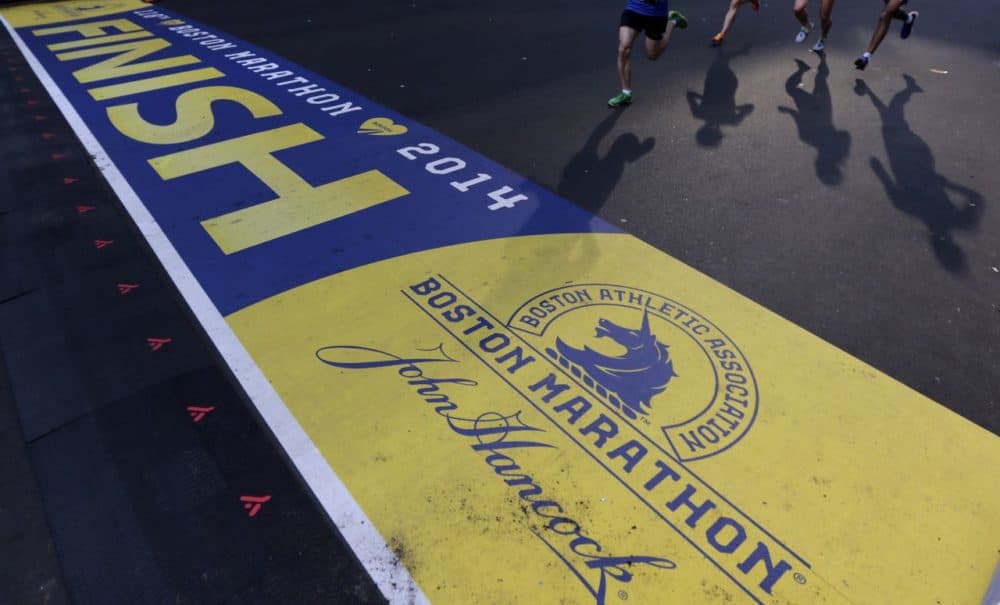Advertisement
Boston Marathon Museum, Clubhouse To Open Soon On Boylston Street

A few blocks from the finish line and even closer to the spot where the second bomb exploded during the 2013 Boston Marathon, race organizers are building a combination clubhouse, interactive museum and retail store that, for the first time, gives them a year-round, public presence.
The Boston RunBase scheduled to open April 16 will allow visitors to learn about the world's most prestigious road race, run a replica of the course on a treadmill, or see artifacts from its 118-year history.
It will give runners a place to gather before going for a jog by the Charles River, and then shower and change before heading back to work or to the convention center across the street.
If they want to pick up a pair of shoes or a Boston Marathon jacket, they can do that, too.
"This RunBase is the front door," Tom Grilk, the executive director of the Boston Athletic Association, said this week before checking in on the construction at the Boylston Street storefront. "It is intended to be a place where the visitor can touch the history, the tradition of the Boston Marathon, and then get out and do something, go for a run themselves."
A combined effort between the B.A.A., Adidas and longtime shoe-seller Marathon Sports, which is providing the staff and retail know-how, the Boston RunBase is a shoeseum of sorts: part shoe store, part museum. It is the sixth RunBase for Adidas — the first in the U.S. But it will differ from locations from Tokyo to Prague, as well as the Nike store nearby, because of its association with the Boston Marathon.
"When someone participates in the Boston Marathon, they feel like they are added to the honor roll. ... You just have that connection with the people that have preceded you. And you know that you are following, literally, in their footsteps."
Jack Fleming, B.A.A. spokesman
"Not only is the Boston Marathon the Carnegie Hall of running, but Boston is an amazing running community," said Mikal Peveto, Adidas' director of running innovation.
And that became even more apparent after two bombs interrupted the 2013 race, attacks that galvanized runners and turned the Boston Marathon into a symbol of the city's resilience.
"It drew the global running community together over something that's kind of ours, as runners," Peveto said. "It changed everything. From something so tragic, it was incredibly powerful what came out of that ... realizing that we had something even more special than we had before."
A running club that had long been associated primarily with its flagship race, the B.A.A. had spent the last 15 years expanding its calendar to include a half-marathon in the fall and a 5K and 10K in the spring and summer. But the organization remained tucked away a few blocks from the course in offices decorated with memorabilia that can be seen, Grilk said, by "essentially nobody."
"We thought: Why not take all this stuff and bring it out to the street?" he said. "If you can be engaged with the community, you have a chance. You may still screw things up, but you have a chance. Otherwise, you're just the guys who are stopping traffic."
The B.A.A. plans to use the RunBase for special events, including clinics and meet-ups where recreational joggers can connect or get tips from coaches before heading out on a run. Lockers and showers will save them a trip home to change; those staying at one of the Back Bay's dozens of hotels might be sent by the front desk to find a running partner or a good route for, say, a leisurely 5K.
The site is about one block after marathon runners turn off of Hereford Street for the final stretch to the finish line, not far from the Charles River Esplanade that is one of the city's prettiest backdrops for a run. It is across the street from the Hynes Convention Center, which hosts a shoulder-to-shoulder runners' expo on marathon weekend and events throughout the year.
"For me, it doesn't matter if it's a dental convention or a running convention," Peveto said. "Right outside on Boylston Street, when they walk outside, they're going to see that RunBase."

Much of the memorabilia had been on display in the B.A.A. offices. Other items, like the sweatshirt Kathrine Switzer wore when she became the first woman to enter the race — and when a race official tried to bodily remove her from the course — were locked away in drawers.
Now they will be included in rotating exhibits, along with records of every Boston Marathon competitor in one place for the first time. "You could go in there and say, 'Hey, my dad ran this in 1972.' And click, click, click, you could look up your dad," Peveto said.
Said B.A.A. spokesman Jack Fleming: "This will be our Ellis Island."
"When someone participates in the Boston Marathon, they feel like they are added to the honor roll. It's almost like being a part of an alumni association: You just have that connection with the people that have preceded you," he said. "And you know that you are following, literally, in their footsteps."